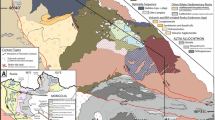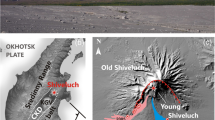Abstract
Petrologic studies of tephra from Kanaga, Adak, and Great Sitkin Islands indicate that amphibole fractionation and magma mixing are important processes controlling the composition of calc-alkaline andesite and dacite magmas in the central Aleutians. Amphibole is ubiquitous in tephra from Kanaga and Adak Islands, whereas it is present only in a basaltic-andesite pumice from Great Sitkin. Dacitic tephra from Great Sitkin do not contain amphibole. Hornblende dacite tephra contain HB+PLAG+OX±OPX±CPX phenocrysts with simple zoning patterns, suggesting that the dacites evolved in isolated magma chambers. Andesitic tephra from Adak contain two pyroxene and hornbelende populations, and reversely zoned plagioclase, indicating a more complex history involving mixing and fractional crystallization. Mass balance calculations suggest that the andesitic tephra may represent the complements of amphibole-bearing cumulate xenoliths, both formed during the evolution of high-Al basalts. The presence of amphibole in andesitic and dacitic tephra implies that Aleutian cale-alkaline magmas evolve in the mid to lower crust under hydrous (>4 wt.% H2O) and oxidizing (≈Ni−NiO) conditions. Amphibole-bearing andesites and pyroxene-bearing dacites from Great Sitkin indicates fractionation at several levels within the arc crust. Despite its absence in many calc-alkaline andesite and dacite lavas, open system behavior involving amphibole fractionation can explain the trace element characteristies of lavas found on Adak Island. Neither open nor closed system fractionation involving a pyroxene-bearing assemblage is capable of explaining the trace element concentrations or ratios found in the Adak suite. We envision a scenario where amphibole was initially a liquidus phase in many calc-alkaline magmas, but was later replaced by pyroxenes as the magmas rose to shallow levels within the crust. The mineral assemblage in these evolved lavas reflects shallow level equilibration of the magma, whereas the trace element chemistry provides evidence for a earlier, amphibole-bearing, mineral assemblage.
Similar content being viewed by others
References
Anderson AT (1980) Significance of hornblende in calc-alkaline andesites and basalts. Am Mineral 65:837–851
Allen JC, Boettcher AL (1978) Amphiboles in andesite and basalt: II. stability as a function of P−T−fH2O−fO2. Am Mineral 65:1074–1087
Baker DR (1987) Depths and water content of magma chambers in the Aleutian and Mariana island arcs. Geology 15:496–499
Baker DR, Eggler DH (1987) Compositions of anhydrous and hydrous melts coexisting with plagioclase, augite and olivine or low-Ca pyroxene from 1 atm to 8 kbar: application to the Alcutian volcanic center of Atka. Am Mineral 72:12–28
Barton M, Huijsmans PP (1986) Post-caldera dacites from the Santorini volcanic complex, Aegean Sea, Greece: an example of the eruption of lavas of near-constant composition over a 2,200 year period. Contrib Mineral Petrol 94:472–495
Blake S (1984) Volatile oversaturation during the evolution of silicic magma chambers as an eruption trigger. J Geophys Res 89:8237–8244
Black RF (1980) Isostatic, tectonic, and eustatic movements of sea level in the Aleutian Islands, Alaska. In: Earth rheology, isostacy and eustacy. J Wiley, 599 p
Carmichael ISE (1967) The iron-titanium oxides of salic volcanic rocks and their associated ferromagnesian silicates. Contrib Mineral Petrol 14:36–64
Cawthorn RG, O'Hara MJ (1976) Amphibole fractionation in calcalkaline magma genesis. Am J Sci 276:309–329
Coats RR (1956a) Geology of northern Adak Island, Alaska. US Geol Surv Bull 1028-C:45–67
Coats RR (1956b) Geology of northern Kanaga Island, Alaska. US Geol Surv Bull 1028-D:69–80
Conrad WK, Kay RW (1984) Ultramafic and mafic inclusions from Adak Island: crystallization history, and implications for the nature of primary magmas and crustal evolution in the Aleutian arc. J Petrol 25:88–125
DeBari S, Kay SM, Kay RW (1987) Ultramafic xenoliths from Adagdak volcano, Adak, Aleutian islands, Alaska: deformed igneous cumulates from the moho of an island arc. J Geol 95:329–341
Delong SE, Perfit MR, McCulloch MT, Ach J (1985) Magmatic evolution of Semisopochnoi Island, Alaska: trace element and isotopic constraints. J Geol 93:609–618
Eggler DH (1972) Amphibole stability in H2O-undersaturated calc-alkaline melts. Earth Planet Sci Lett 15:28–34
Eggler DH, Burnham CW (1973) Crystallization and fractionation trends in the system andesite-H2O−CO2−O2 at pressures, to 10 Kb. Geol Soc Am Bull 84:2517–2532
Ewart A, Hildreth W, Carmichael ISE (1975) Quaternary acid magma in New Zealand. Contrib Mineral Petrol 51:1–27
Fujimaki H, Tatsumoto M, Aoki K (1984) Partition coefficients of Hf, Zr, and REE between phenocrysts and groundmass. Proceedings of the 14th Lunar and Planetary Science Conference, Part 2, J Geophys Res 89, Suppl: B662-672
Fregeau EJ (1982) Mineralogy of postglacial ashes, Adak Island Alaska. Unpublished Senior Thesis, Department of Geological Sciences, Cornell University, 31 p
Geist EL, Childs JR, Scholl DW (1988) The origin of summit basins of the Aleutian ridge: implications for block rotation of an arc massif. Tectonics 7, N. 2:327–341
Gilbert MC, Heltz RT, Popp RK, Spear FS (1982) Experimental studies of amphibole stability. In: De Veblen, P Ribbe (eds) Amphiboles: petrology and experimental phase relations. Reviews in Mineralogy, Mineral Soc Am: 229–346
Green TH, Pearson NJ (1985) Experimental determination of REE partition coefficients between amphibole and basaltic to andesitic lipids as high pressure. Geochim Cosmochim Acta 49:1465–1468
Grove TL, Donnelly-Nolan JM (1986) The evolution of young silicic lavas at Medicine Lake Volcano, California: implications for the origin of compositional gaps in calcalkaline series lavas. Contrib Mineral Petrol 92:281–302
Hagerty SE (1976) Opaque mineral oxides in terrestrial igneous rocks. In: D Rumble (ed) Oxide minerals. Reviews in mineralogy 3: 101–300
Hildreth W (1983) The compositionally zoned eruption of 1912 in the Valley of Ten Thousand Smokes, Katmai National Park, Alaska. J Volcanol Geotherm Res 18:1–56
Helz RT (1973) Phase relations of basalts in their melting range at PH 2 0=5 kb as a function of oxygen fugacity, part I. Mafic phases, J Petrol 14, Part 2:249–302
Kay RW (1978) Aleutian magnesian andesites: melts from subducted Pacific Ocean crust. J Volcanol Geotherm Res 4:117–132
Kay RW, Rubenstone JL, Kay SM (1986) Aleutian terranes from Nd isotopes. Nature 322:605–609
Kay SM, Makseaev V, Moscoso R, Mpodozis C, Nasi C (1987) Probing the evolving Andean lithosphere: Mid-late Tertiary magmatism in Chile (29°–30°30′s) over the modern zone of subhorizontal subduction. J Geophys Res 92, B7:6173–6189
Kay SM, Kay RW (1985) Alcutian tholeiitic and calc-alkaline magma series, I: the mafic phenocrysts. Contrib Mineral Petrol 90:276–290
Kay SM, Kay RW, Citron GP (1982) Tectonic controls on tholeiitic and calc-alkaline magmatism in the Aleutian Arc. J Geophys Res 87, N. B5:4051–4072
Kay SM, Kay RW (1991) Aleutian magmas in space and time. Decade of North American Geology, Geol Soc Am (in press)
Kienle J, Swanson SE, Pulpan H (1983) Magmatism and subduction in the eastern Aleutian Arc. In: D Shimozuru, I Yokoyama (eds) Are volcanism: physics and tectonics. Reidel, pp 191–224
LeMaitre RW (1981) Genmix-a generalized petrological mixing model program. Comp Geosci 7:299–247
Lerbekmo JF, Campbell FA (1969) Distribution, composition and source of the White River ash, Yukon Territory. Can J Earth Sci 6:106–116
Lindsley DH (1983) Pyroxene thermometry. The Am Mineral 68:477–493
Loomis TP (1982) Numerical simulations of crystallization processes of plagioclase in complex melts: the origin of major and oscillatory zoning in plagioclase. Contrib Mineral Petrol 81:219–229
Marsh BD (1982) The Aleutians. In: RS Thorpe (ed) Andesites. J Wiley, pp 99–114
Mathez EA (1973) Refinement of the Kudo-Weill plagioclase thermometer and its application to basaltic rocks. Contrib Mineral Petrol 41:61–72
Melson WG, Hopson CA (1981) Preeruption temperatures and oxygen fugacities in the 1980 eruptive sequence. US Geol Surv Bul Prof Pap 1250:641–648
Merzbacher C, Eggler DH (1984) A magmatic geohygrometer: application to Mount St. Helens and other dacitic magmas. Geology 12:587–590
McCulloch MA, Perfit MR (1981) 143Nd/144Nd, 87Sr/86Sr and trace element constraints on the petrogenesis of Aleutian island are magmas. Earth Planet Sci Lett 56:167–179
Morris JD, Hart SR (1983) Isotopic and incompatible element constraints on the genesis of island arc volcanics from Cold Bay and Amak Island, Aleutians, and implications for mantle structure. Geochim Cosmochim Acta 47:2015–2030
Myers JD, Marsh BD, Sinha AK (1985) Strontium isotopic and selected trace element variations between two Aleutian volcanic centers (Adak and Atka): implications for the development of arc volcanic plumbing systems. Contrib Mineral Petrol 91:221–234
Nagasawa H, Schnetzler CC (1971) Partitioning of rare earth, alkali and alkaline earth elements between phenocrysts and acidic igneous magma. Geochim Cosmochim Acta 35:953–968
Neuweld MA (1987) The petrology and geochemistry of the Great Sitkin suite: Implications for the genesis of calc-alkaline magmas. Unpublished MS Thesis, Cornell University, Ithaca, NY, 174 p
Nixon GT (1988) Petrology of the younger andesites and dacites of Iztaccihuatl Volcano, Mexico: I. disequilibrium phenocryst assemblages as indicators of magma chamber processes. J Petrol 29:213–264
Nye CJ, Reid MR (1986) Geochemistry of primary and least fractionated lavas from Okmok Volcano, central Aleutians: implications for arc magmagenesis. J Geophys Res 91:10,271–10,287
Philpotts JA, Schnetzler CC (1970) Phenocryst-matrix partition coefficients for K, Rb, Sr and Ba, with applications to anorthosite and basalt genesis. Geochim Cosmochim Acta 34:307–322
Ritchey JL, Eggler DH (1978) Amphibole stability in a differentiated calc-alkaline magma chamber: an experimental investigation Carnegie Institution of Washington Yearbk: 790–793
Ritchey JL (1980) Divergent magmas at Crate Lake, Oregon: products of fractional crystallization and vertical zoning in a shallow, water-undersaturated chamber. J Volcanol Geotherm Res 7:373–386
Rutherford MJ, Sigurdsson H, Carey S, Davis A (1985) The May 18, 1980, eruption of Mount St Helens, 1. melt composition and experimental phase equilibria. J Geophys Res 90:2929–2947
Rutherford MJ, Devine J (1986) Experimental petrology of recent Mount St. Helens dacites: amphibole, Fe−Ti oxides and magma chamber conditions. Geol Soc Am Abst: 736
Rutherford MJ, Devine J (1988) The May 18, 1980, Eruption of Mount St. Helens 3. Stability and chemistry of amphibole in the magma chamber. J Geophys Res 93, B10:11949–11959
Sarna-Wojcicki AM, Meyer CF, Woodward MJ, Lamothe PJ (1981) Composition of air-fall ash erupted on May 18, May 25, June 12, July 22, and August 7. In: The 1980 Eruptions of Mount St Helens, Washington. US Geol Surv Prof Pap 1250:667–681
Schnetzler CC, Philpotts (1970) Partition coefficients of rare-earth elements between igneous matrix material and rock-forming mineral phenocrysts—II. Geochim Cosmochim Acta 34:331–340
Sekine T, Katsura T, Aramaki S (1979) Water saturated phase relations of some andesites with application to the estimation of the initial temperature and water pressure at the time of eruption. Geochim Cosmochim Acta 43:1367–1376
Smith DR, Leeman WP (1987) Petrogenesis of Mount St Helens dacitic magmas. J Geophys Res 92:10,313–10,334
Snyder GL (1959) Geology of Little Sitkin Island, Alaska. US Geol Surv Bul 1028-H:169–210
Von Drach V, Marsh BD, Wasserburg GJ (1986) Nd and Sr isotopes in the Aleutians: multicomponent parenthood of island-arc magmas. Contrib Mineral Petrol 92:13–34
White WM, Patchett J (1984) Hf−Nd−Sr isotopes and incompatible element abundances in island arcs: implications for magma origins and crust mantle
Author information
Authors and Affiliations
Rights and permissions
About this article
Cite this article
Romick, J.D., Kay, S.M. & Kay, R.W. The influence of amphibole fractionation on the evolution of calc-alkaline andesite and dacite tephra from the central Aleutians, Alaska. Contrib Mineral Petrol 112, 101–118 (1992). https://doi.org/10.1007/BF00310958
Received:
Accepted:
Issue Date:
DOI: https://doi.org/10.1007/BF00310958




